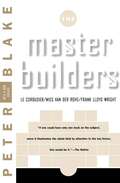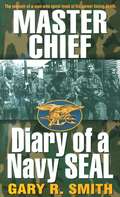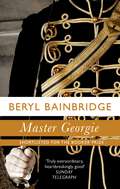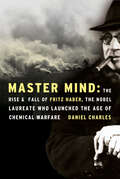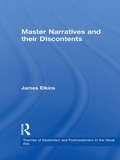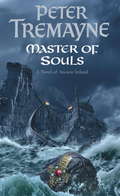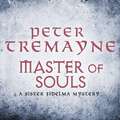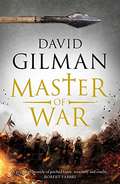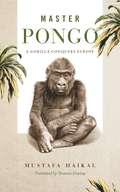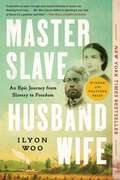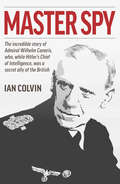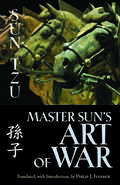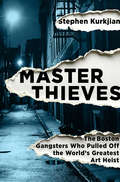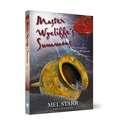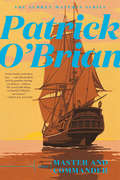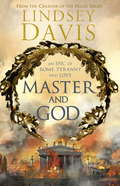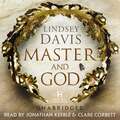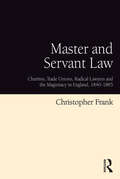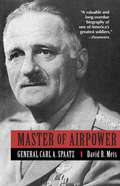- Table View
- List View
Master Builders: Le Corbusier, Mies Van Der Rohe, And Frank Lloyd Wright
by Peter BlakeThe story of modern architecture is told here through the lives and works of three men who changed the face of the cities we live in. Le Corbusier gave to modern design a sure and brilliant sense of form; Mies brought an almost Gothic discipline of structure; and Wright heralded a new and dramatic concept of space and freedom. Through this triple focus, Peter Blake provides a perspective on the entire range of twentieth-century architecture. 129 photographs and 22 drawings
Master Chief: Diary of a Navy Seal
by Alan Maki Gary SmithIT'S HARD TO BE HUMBLEWHEN YOU'RE SERVING WITH THE VERY BESTFor UDT/SEAL team member Gary R. Smith, just being part of an elite military organization wasn't enough--he had to be in the thick of the action. Because in bloody, violent Vietnam he learned there's no stronger bond than the one forged in the gut-wrenching chaos of combat. During ambushes, PRU combat patrols, and extractions from hot LZs, Smith depended on the courage and sacrifice of his fellow SEALs, who time and again placed their own lives on the line so that he might survive.In MASTER CHIEF, Gary Smith covers his fifth tour in Vietnam and his rise to the highest enlisted rank, master chief petty officer. Characteristically, Smith holds nothing back when describing life during wartime in one of the world's toughest fighting units.Based on the author's own experience, as well as his own and others' diaries, letters, and documents, and on extensive interviews, MASTER CHIEF is an outstanding memoir of a warrior who answered the call to arms whenhis country needed him.From the Paperback edition.
Master Georgie: A Novel
by Beryl BainbridgeShortlisted for the Man Booker Prize: A masterwork of love, guilt, and friendship set in Victorian Liverpool and Eastern Europe during the Crimean War. Photography is the common thread weaving together three different points of view that span the years from 1846 to 1854. The first "plate" opens with the account of Myrtle, a young orphan girl, as she is taking a photograph of her adoptive father, Mr. Hardy, who has just passed away in Liverpool. The sudden and unsavory circumstances of Mr. Hardy's death bind Myrtle and the other characters of this story together as history propels them toward the frontlines of the Crimean War. Myrtle's adoptive brother, George Hardy, or "Master Georgie" as he is called, is an amateur photographer and handsome surgeon. When he heads east in 1854 to offer his medical services to the conflict raging between Russia and Turkey--a war it seems England will inevitably enter--Myrtle follows him, as does George's brother-in-law, a high-minded geologist named Dr. Potter. The group travels to Valetta, Malta, and Constantinople, then on to Varna, where George will be stationed. As the caravan proceeds, the group crosses paths with Pompey Jones, a street urchin, photographer's assistant, and sometimes fire breather, who is a dear friend of George's and was with him the day his father died. It soon becomes clear that George's affections are torn between Pompey and Myrtle. Dr. Potter, meanwhile, pines for the affections of his wife, who is hundreds of miles away. The conflicting emotions in the travelers' hearts are amplified by the misery, disease, and filth they must endure--as well as the other, more unthinkable, horrors of war. A sparse yet vivid historical novel, Master Georgie delves into themes of distorted truth, the psychological effects of war, unrequited love, and the will to survive. Called "a true novelist's novel" by the Guardian, it was shortlisted for the Man Booker Prize. This ebook features an illustrated biography of Beryl Bainbridge including rare images from the author's estate.
Master Georgie: Shortlisted for the Booker Prize, 1998
by Beryl BainbridgeSHORTLISTED FOR THE BOOKER PRIZE 1998SHORTLISTED FOR THE GUARDIAN FICTION PRIZEWINNER OF THE JAMES TAIT MEMORIAL PRIZE FOR FICTIONWINNER OF THE WH SMITH BOOK OF THE YEAR AWARDWhen Master Georgie - George Hardy, surgeon and photographer - sets off from the cold squalor of Victorian Liverpool for the heat and glitter of the Bosphorus to offer his services in the Crimea, there straggles behind him a small caravan of devoted followers; Myrtle, his adoring adoptive sister; lapsed geologist Dr Potter; and photographer's assistant and sometime fire-eater Pompey Jones, all of them driven onwards through a rising tide of death and disease by a shared and mysterious guilt.Combining a breathtaking eye for beauty with a visceral understanding of mortality, Beryl Bainbridge exposes her enigmatic hero as tenderly and unsparingly as she reveals the filth and misery of war, and creates a novel of luminous depth and extraordinary intensity.
Master Mind: The Rise & Fall of Fritz Haber, the Nobel Laureate Who Launched the Age of Chemical Warfare
by Daniel Charles“The dramatic life of a German Jewish scientist caught, of his own will, between the promise of science and the annihilation of war.” —Roald Hoffmann, chemist and writerFRITZ HABER—a Nobel laureate in chemistry, a friend of Albert Einstein, a German Jew and World War I hero—may be the most important scientist you have never heard of. The Haber-Bosch process, which he invented at the turn of the twentieth century, revolutionized agriculture by converting nitrogen to fertilizer in quantities massive enough to feed the world. The invention has become an essential pillar for life on earth; some two billion people on our planet could not survive without it. Yet this same process supplied the German military with explosives during World War I, and Haber orchestrated Germany’s use of an entirely new weapon—poison gas. Eventually, Haber’s efforts led to Zyklon B, the gas later used to kill millions—including Haber’s own relatives—in Nazi concentration camps.Master Mind is a thought-provoking biography of this controversial scientist, a modern Faust who personifies the paradox of science, its ability to create and to destroy. It offers a complete chronicle of his tumultuous and ultimately tragic life, from his childhood and rise to prominence in the heady days of the German Empire to his disgrace and exile at the hands of the Nazis; from early decades as the hero who eliminated the threat of starvation to his lingering legacy as a villain whose work led to the demise of millions.“A fascinating tale of science, history, politics, and antisemitism . . . exceptionally compelling reading.” —Deborah Lipstadt, author of Denying the Holocaust
Master Narratives and their Discontents (Theories of Modernism and Postmodernism in the Visual Arts #Vol. 1)
by James ElkinsIn this bracing engagement with the many versions of art history, James Elkins argues that the story of modernism and postmodernism is almost always told in terms of four narratives. Works of art are either seen as modern or postmodern, or praised for their technical skill or because of the politics they appear to embody. These are master narratives of contemporary criticism, and each leads to a different understanding of what art is and does. Both a cogent overview of the state of thinking about art and a challenge to think outside the art historical box, Master Narratives and their Discontents is the first volume in a series of short books on the theories of modernism by leading art historians on twentieth-century art and art criticism.
Master Of Souls (Sister Fidelma Mysteries Book 16): A chilling historical mystery of secrecy and danger
by Peter TremayneSister Fidelma must find the link that connects the mysterious crimes in MASTER OF SOULS, Peter Tremayne's brilliant sixteenth novel in the ever-popular Sister Fidelma mystery series.PRAISE FOR THE SISTER FIDELMA SERIES: 'A compulsive readable whodunit fronted by one of the most reliably intriguing characters to grace the pages of the genre' BooklistOn a storm-driven night, wreckers drive a ship onto rocks off the coast of Ireland. An Abbess leading a pilgrimage is killed and the young religieuse with her abducted. An ageing scholar is murdered in the Abbey of Ard Fhearta. Do these events have a connection?Sister Fidelma and Brother Eadulf go to Ard Fhearta to examine the mystery. But the abbey stands in the territory of the Uí Fidgente, enemies of Fidelma and her brother, the King of Cashel, and danger threatens Fidelma and Eadulf from the moment of their arrival.What is the link that connects the crimes? Who is the mysterious `master of souls' spreading death and corruption across the land? Has Uaman the Leper, Lord of the Passes, returned from the dead?What readers are saying about MASTER OF SOULS:'Absolutely gripping from start to finish. Could not put it down''MASTER OF SOULS gives us more insight into the customs of ancient Ireland, as well as an interesting mystery to unravel''Peter Tremayne writes some of the best historical mysteries due in part to his heroine, a woman living in an enlightened country when the rest of Europe is going through the dark ages'
Master Of Souls: A chilling historical mystery of secrecy and danger (Sister Fidelma)
by Peter TremayneSister Fidelma must find the link that connects the mysterious crimes in MASTER OF SOULS, Peter Tremayne's brilliant sixteenth novel in the ever-popular Sister Fidelma mystery series.PRAISE FOR THE SISTER FIDELMA SERIES: 'A compulsive readable whodunit fronted by one of the most reliably intriguing characters to grace the pages of the genre' BooklistOn a storm-driven night, wreckers drive a ship onto rocks off the coast of Ireland. An Abbess leading a pilgrimage is killed and the young religieuse with her abducted. An ageing scholar is murdered in the Abbey of Ard Fhearta. Do these events have a connection?Sister Fidelma and Brother Eadulf go to Ard Fhearta to examine the mystery. But the abbey stands in the territory of the Uí Fidgente, enemies of Fidelma and her brother, the King of Cashel, and danger threatens Fidelma and Eadulf from the moment of their arrival.What is the link that connects the crimes? Who is the mysterious `master of souls' spreading death and corruption across the land? Has Uaman the Leper, Lord of the Passes, returned from the dead?What readers are saying about MASTER OF SOULS:'Absolutely gripping from start to finish. Could not put it down''MASTER OF SOULS gives us more insight into the customs of ancient Ireland, as well as an interesting mystery to unravel''Peter Tremayne writes some of the best historical mysteries due in part to his heroine, a woman living in an enlightened country when the rest of Europe is going through the dark ages'
Master Of Souls: A chilling historical mystery of secrecy and danger (Sister Fidelma)
by Peter TremayneSister Fidelma must find the link that connects the mysterious crimes in MASTER OF SOULS, Peter Tremayne's brilliant sixteenth novel in the ever-popular Sister Fidelma mystery series.On a storm-driven night, wreckers drive a ship onto rocks off the coast of Ireland. An Abbess leading a pilgrimage is killed and the young religieuse with her abducted. An ageing scholar is murdered in the Abbey of Ard Fhearta. Do these events have a connection?Sister Fidelma and Brother Eadulf go to Ard Fhearta to examine the mystery. But the abbey stands in the territory of the Uí Fidgente, enemies of Fidelma and her brother, the King of Cashel, and danger threatens Fidelma and Eadulf from the moment of their arrival.What is the link that connects the crimes? Who is the mysterious `master of souls' spreading death and corruption across the land? Has Uaman the Leper, Lord of the Passes, returned from the dead?(P) Soundings, 2005
Master Of War
by David GilmanAmid the carnage of the 100 Years War – the bloodiest conflict in medieval history – a young English archer confronts his destiny... <p><p> England, 1346: For Thomas Blackstone the choice is easy – dance on the end of a rope for a murder he did not commit, or take up his war bow and join the king's invasion. <p> As he fights his way across northern France, Blackstone learns the brutal lessons of war – from the terror and confusion of his first taste of combat, to the savage realities of siege warfare. <p> Vastly outnumbered, Edward III's army will finally confront the armoured might of the French nobility on the field of Crécy. It is a battle that will change the history of warfare, a battle that will change the course of Blackstone's life, a battle that will forge a legend.
Master Plans and Encroachments: The Architecture of Informality in Islamabad (The City in the Twenty-First Century)
by Faiza MoatasimAmong urban designers and municipal officials, the term encroachment is defined as a deviation from the official master plan. But in cities today, such informal modifications to the urban fabric are deeply enmeshed with formal planning procedures. Master Plans and Encroachments examines informality in the high-modernist city of Islamabad as a strategic conformity to official schemes and regulations rather than as a deviation from them.For the new administrative capital of Pakistan designed in 1959 by Greek architect and planner Constantinos A. Doxiadis, Islamabad’s master plan offers a clear template of formal urban design within which informal spaces and processes have been articulated. Drawing on deep archival research, wide-ranging interviews, and an array of visual material, including photographs, maps, and architectural drawings, Faiza Moatasim shows how Islamabad’s master plan is not simply a blueprint that guides future urban development or makes its violations apparent; it is used by both city officials and citizens to develop informal spaces that accommodate unfulfilled needs and desires of those living and working in the city.Master Plans and Encroachments is the first book that examines the informal practices of both the privileged and the underprivileged. The book highlights how low-, middle-, and upper-income people do not randomly build informal spaces; they strategically use architectural techniques to support their informal claims to space, which are often met with the government’s tacit approval. By focusing on those spaces in Islamabad’s urban fabric that are not part of its official master plan, the book demonstrates how planning actually works in complex ways.
Master Pongo: A Gorilla Conquers Europe (Animalibus)
by Mustafa HaikalIn the summer of 1876, Berlin anxiously awaited the arrival of what was billed as “the most gigantic ape known to zoology.” Described by European explorers only a few decades earlier, gorillas had rarely been seen outside of Africa, and emerging theories of evolution only increased the public’s desire to see this “monster with human features.” However, when he arrived, the so-called monster turned out to be a juvenile male less than thirty-two inches tall. Known as M’Pungu (Master Pongo), or simply Pongo, the gorilla was put on display in the Unter den Linden Aquarium in the center of Berlin. Expecting the horrid creature described by the news outlets of the time, the crowds who flocked to see Pongo were at first surprised and then charmed by the little ape. He quickly became one of the largest attractions in the city, and his handlers exploited him for financial gain and allowed doctors and scientists to study him closely. Throughout his time in Europe, Pongo was treated like a person in many respects. He drank beer, ate meat, slept at the home of the head of the aquarium, and “visited” London and Hamburg. But this new lifestyle and foreign environment weren’t healthy for the little gorilla. Pongo fell ill frequently and died of “consumption” in November 1877, less than a year and a half after being brought to Europe.An irresistible read, illustrated with contemporaneous drawings, this critical retelling of the expedition that brought Pongo to Berlin and of his short life in Europe sheds important light on human-animal interactions and science at a time in Western society when the theory of evolution was first gaining ground.
Master Pongo: A Gorilla Conquers Europe (Animalibus: Of Animals and Cultures #17)
by Mustafa HaikalIn the summer of 1876, Berlin anxiously awaited the arrival of what was billed as "the most gigantic ape known to zoology." Described by European explorers only a few decades earlier, gorillas had rarely been seen outside of Africa, and emerging theories of evolution only increased the public’s desire to see this "monster with human features." However, when he arrived, the so-called monster turned out to be a juvenile male less than thirty-two inches tall. Known as M’Pungu (Master Pongo), or simply Pongo, the gorilla was put on display in the Unter den Linden Aquarium in the center of Berlin. Expecting the horrid creature described by the news outlets of the time, the crowds who flocked to see Pongo were at first surprised and then charmed by the little ape. He quickly became one of the largest attractions in the city, and his handlers exploited him for financial gain and allowed doctors and scientists to study him closely. Throughout his time in Europe, Pongo was treated like a person in many respects. He drank beer, ate meat, slept at the home of the head of the aquarium, and "visited" London and Hamburg. But this new lifestyle and foreign environment weren’t healthy for the little gorilla. Pongo fell ill frequently and died of "consumption" in November 1877, less than a year and a half after being brought to Europe.An irresistible read, illustrated with contemporaneous drawings, this critical retelling of the expedition that brought Pongo to Berlin and of his short life in Europe sheds important light on human-animal interactions and science at a time in Western society when the theory of evolution was first gaining ground.
Master Skylark
by John BennettAn exciting story set in an accurate reproduction of the life and color of Elizabethan England.
Master Slave Husband Wife: An Epic Journey from Slavery to Freedom
by Ilyon WooWinner of the 2024 Pulitzer Prize in Biography &“A rich narrative of the Crafts, an enslaved couple who escaped from Georgia in 1848, with light-skinned Ellen disguised as a disabled white gentleman and William as her manservant, exploiting assumptions about race, class, and disability to hide in public on their journey to the North, where they became famous abolitionists while evading bounty hunters.&” —The Pulitzer Prizes Named one of the best books of the year by The New York Times, The New Yorker, Time, NPR, Smithsonian Magazine, and Oprah DailyIn 1848, a year of international democratic revolt, a young, enslaved couple, Ellen and William Craft, achieved one of the boldest feats of self-emancipation in American history. Posing as master and slave, while sustained by their love as husband and wife, they made their escape together across more than 1,000 miles, riding out in the open on steamboats, carriages, and trains that took them from bondage in Georgia to the free states of the North.Along the way, they dodged slave traders, military officers, and even friends of their enslavers, who might have revealed their true identities. The tale of their adventure soon made them celebrities, and generated headlines around the country. Americans could not get enough of this charismatic young couple, who traveled another 1,000 miles criss-crossing New England, drawing thunderous applause as they spoke alongside some of the greatest abolitionist luminaries of the day—among them Frederick Douglass and William Wells Brown.But even then, they were not out of danger. With the passage of an infamous new Fugitive Slave Act in 1850, all Americans became accountable for returning refugees like the Crafts to slavery. Then yet another adventure began, as slave hunters came up from Georgia, forcing the Crafts to flee once again—this time from the United States, their lives and thousands more on the line and the stakes never higher.With three epic journeys compressed into one monumental bid for freedom, Master Slave Husband Wife is an American love story—one that would challenge the nation&’s core precepts of life, liberty, and justice for all—one that challenges us even now.
Master Spy
by Ian ColvinMaster Spy, first published in 1951, recounts the career of Admiral Wilhelm Canaris, who served as Hitler's Chief of Intelligence for nine years, but who was a quiet supporter of the German resistance to Hitler. Charming, exacting, mistrustful, and soft-spoken, Canaris became an Admiral during the WWI, but officially entered the Abwehr (Security Service) in 1935 of which he was later to become head. The book details the military and diplomatic interchanges in which he took part, including the incidents in which Canaris sabotaged and betrayed German plans, from the Munich pact to the proposed invasion of England and throughout the war, until his deposition by Hitler in 1944, and his execution in 1945. Perhaps most importantly, Canaris personally talked General Franco out of entering the war on Germany’s side, arguing that he would be aligning himself with the wrong side. This prevented any assault on Gibraltar and kept the Mediterranean open for allied shipping. Without Canaris, the allies would have had significant difficulty in launching their North African, Sicilian or Italian campaigns.After Stauffenberg’s July 20, 1944 bomb plot against Hitler, the Canaris group was implicated, arrested and transferred to various concentration camps. In September 1944, incriminating documents were found in the safe of Abwehr officer Werner Schrader following that officer’s July 28, 1944 suicide. Later, Canaris’ complete personal diary was found in another safe at Zossen. The diaries made clear that Canaris had been playing a double game against the Nazis since before the war, enraging Hitler. On April 9, 1945, Canaris and several other members of the Abwehr resistance circle were put on trial in an SS kangaroo court and were hung at KZ Flossenburg on Hitler’s direct orders.Author Ian Colvin, a correspondent of the London News Chronicle, had worked in pre-war Berlin where he made secret contacts with anti-Nazis. He was later expelled from Germany.
Master Sun's Art of War
by Sun Tzu Philip J. IvanhoePhilip J. Ivanhoe's translation of Sun Tzu's Art of War will be warmly embraced by students. His discussion in the Introduction about the text's dating and authorship, as well as Chinese attitudes towards things military, is concise, informative, and up-to-date. The translation itself is a marvel--its language is simple and direct, making it immensely readable and clear.--Keith Knapp, is Westvaco Professor of National Security Studies, Department of History, The Citadel, The Military College of South Carolina
Master Thieves: The Boston Gangsters Who Pulled Off the World's Greatest Art Heist
by Stephen KurkjianIn a secret meeting in 1981, a master thief named Louis Royce gave career gangster Ralph Rossetti the tip of a lifetime. As a kid, Royce had visited the Isabella Stewart Gardner Museum and made a habit of sneaking in at night to find a good place to sleep. He knew the Museum's security was lax, and he gave this information to a boss of the Boston criminal underworld.It took years before the Museum was hit. But when it finally happened, it quickly became one of the most infamous art heists in history: 13 works of art valued at up to $500 million--including Rembrandt's "The Storm on the Sea of Galilee." The identity of the thieves were a mystery, the paintings were never found.What happened in those intervening years? Which Boston crew landed the big score? And why, more than 20 years later, did the FBI issue a press conference stating that they knew who had pulled off the heist and what had happened to the artwork, but provided no identities and scant details?These mysteries are the story of Kurkjian's revealing book. The best and longest-tenured reporter on this case, and one of the most decorated investigative reporters in America, Kurkjian will reveal the identities of this who plotted the heist, the motive for the crime, and the details that the FBI refused to reveal. He will take the reader deep into the Boston mob, and paint the most complete and compelling picture of this story ever told.
Master Wycliffe's Summons (The Chronicles of Hugh De Singleton, Surgeon #14)
by Mel StarrOne of Master John Wycliffe's scholars is found dead after a thunderstorm. Was he struck by lightning, or was there something more sinister to his death? Scholar Richard Sabyn, a particularly obnoxious fellow, was believed to have been struck by lightning. However, Master Wycliffe believes otherwise and calls upon Sir Hugh de Singleton for help. Sir Hugh shares Wycliffe's suspicions and launches a private investigation, learning that it might indeed be possible to make it look as though a man has died from a lightning strike. But who would go to all that effort, and why? When fellow scholar Simon Duby dies, it raises even more questions and suspicions. What is the connection between the two men? Sir Hugh believes a bronze pot, a bucket of urine, and a small quantity of charcoal and brimstone may hold the answer. During a bleak 1375, can he survive the insidious plague and several attempts on his life as he continues his quest for truth?
Master and Commander (Aubrey/Maturin Novels #(Vol. Book 1))
by Patrick O'BrianThis, the first in the splendid series of Jack Aubrey novels, establishes the friendship between Captain Aubrey, R.N., and Stephen Maturin, ship's surgeon and intelligence agent, against a thrilling backdrop of the Napoleonic wars. Details of a life aboard a man-of-war in Nelson's navy are faultlessly rendered: the conversational idiom of the officers in the ward room and the men on the lower deck, the food, the floggings, the mysteries of the wind and the rigging, and the roar of broadsides as the great ships close in battle.
Master and God
by Lindsey DavisAfflicted by classic paranoia, the self-styled Master and God sees enemies everywhere. As he vents his suspicions, no one is safe. A reluctant hero, Gaius Vinius Clodianus is hand-picked for high rank in the Praetorian Guard a brave man striving for decency in a world of corruption and deceit. Flavia Lucilla, tending the privileged women at court, hears the intimate secrets of a ruler who plays with the lives of his subjects as if he were indeed a careless god. In the dark shadow of Domitian's reign, Clodianus and Lucilla play out their own complex tale of resilience, friendship and love. Unwilling witnesses to Domitian's descent into insanity, these ordinary people must choose between their sworn duty to protect the Emperor and an act of courage that will change the future of Rome.
Master and God
by Lindsey DavisAD81. The Roman Emperor Domitian seizes power. Afflicted by classic paranoia, the self-styled Master and God sees enemies everywhere - and he is right. The Senate loathes him, his advisers are terrified, he cannot trust his wife and barbarians menace the frontiers. As he vents his suspicions, no one is safe...Gaius Vinius Clodianus survives physical and mental scars to reach high rank in the Praetorian Guard. Flavia Lucilla tends the privileged women at court; when Domitian's inherited talent unravels into madness, she loses her patron cruelly. In the haven of their shared apartment, Gaius and Lucilla find solace together, yearning for normality while living in a Reign of Terror.Moves against Domitian are begun by his own household. Lucilla has to watch Gaius choose between love for her and risking death; between his sworn duty to protect the Emperor and killing Domitian for the good of Rome.The plot careers close to exposure. Rome teeters on the brink of its Golden Age. A group of unlikely conspirators must now act with decency and courage, whatever the personal cost.Master and God is the epic story of a despot whose contemporaries wrote him out of history. Told in Lindsey Davis' sardonic style, it is an intimate portrait of resilience, friendship and love.(P)2012 Hodder & Stoughton
Master and God: A Novel Of Ancient Rome
by Lindsey DavisAfflicted by classic paranoia, the self-styled Master and God sees enemies everywhere. As he vents his suspicions, no one is safe. A reluctant hero, Gaius Vinius Clodianus is hand-picked for high rank in the Praetorian Guard a brave man striving for decency in a world of corruption and deceit. Flavia Lucilla, tending the privileged women at court, hears the intimate secrets of a ruler who plays with the lives of his subjects as if he were indeed a careless god. In the dark shadow of Domitian's reign, Clodianus and Lucilla play out their own complex tale of resilience, friendship and love. Unwilling witnesses to Domitian's descent into insanity, these ordinary people must choose between their sworn duty to protect the Emperor and an act of courage that will change the future of Rome.
Master and Servant Law: Chartists, Trade Unions, Radical Lawyers and the Magistracy in England, 1840–1865
by Christopher FrankIn recent years, social and legal historians have called into question the degree to which the labour that fuelled and sustained industrialization in England was actually ’free’. The corpus of statutes known as master and servant law has been a focal point of interest: throughout the eighteenth and nineteenth centuries, at the behest of employers, mine owners, and manufacturers, Parliament regularly supplemented and updated the provisions of these statutes with new legislation which contained increasingly harsh sanctions for workers who left work, performed it poorly, or committed acts of misbehaviour. The statutes were characterized by a double standard of sanctions, which treated workers’ breach of contract as a criminal offence, but offered only civil remedies for the broken promises of employers. Surprisingly little scholarship has looked into resistance to the Master and Servant laws. This book examines the tactics, rhetoric and consequences of a sustained legal and political campaign by English and Welsh trade unions, Chartists, and a few radical solicitors against the penal sanctions of employment law during the mid-nineteenth century. By bringing together historical narratives that are all too frequently examined in isolation, Christopher Frank is able to draw new conclusions about the development of the English legal system, trade unionism and popular politics of the period. The author demonstrates how the use of imprisonment for breach of a labour contract under master and servant law, and its enforcement by local magistrates, played a significant role in shaping labour markets, disciplining workers and combating industrial action in many regions of England and Wales, and further into the British Empire. By combining social and legal history the book reveals the complex relationship between parliamentary legislation, its interpretation by the high courts, and its enforcement by local officials. This work marks an important contribution to legal
Master of Airpower: General Carl A. Spatz
by David MetsMaster of Airpower recounts the life of General Carl "Tooey" Spaatz. He helped formulate the U.S. "strategic airpower" military doctrine in WWII and, in 1947, became chief of staff of the Air Force, a newly independent arm of the military. Master of Airpower offers a great history lesson about WWII and the U.S. Air Force.
